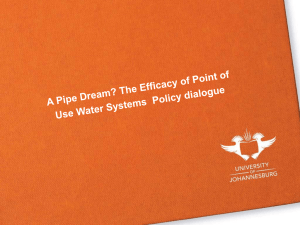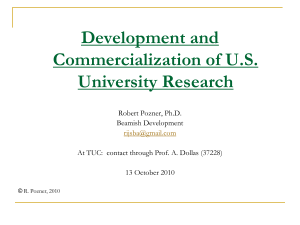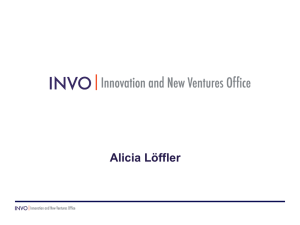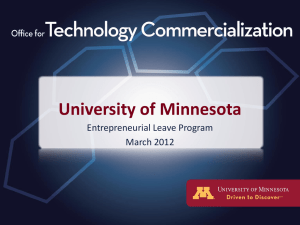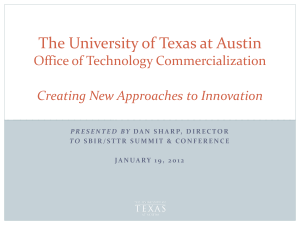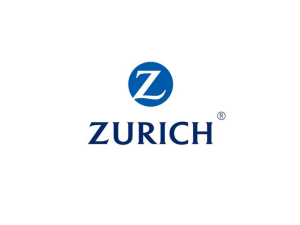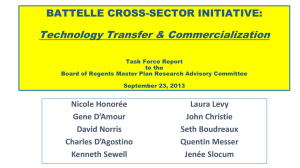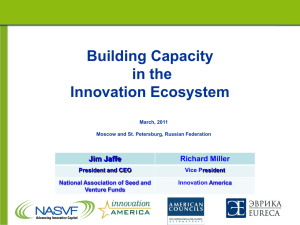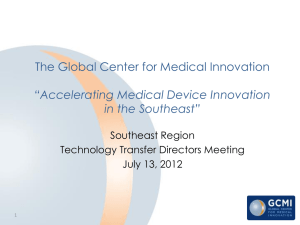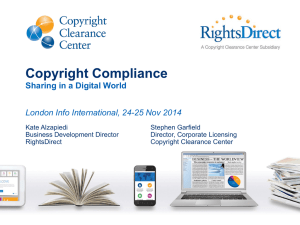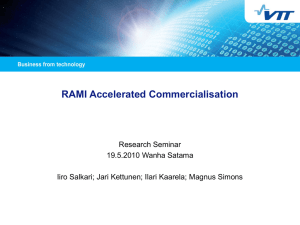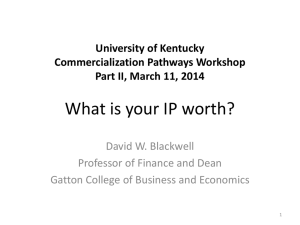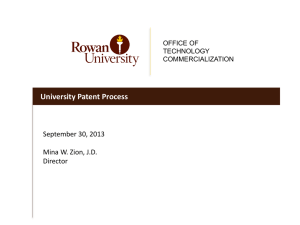Presentation - Michigan Technological University
advertisement
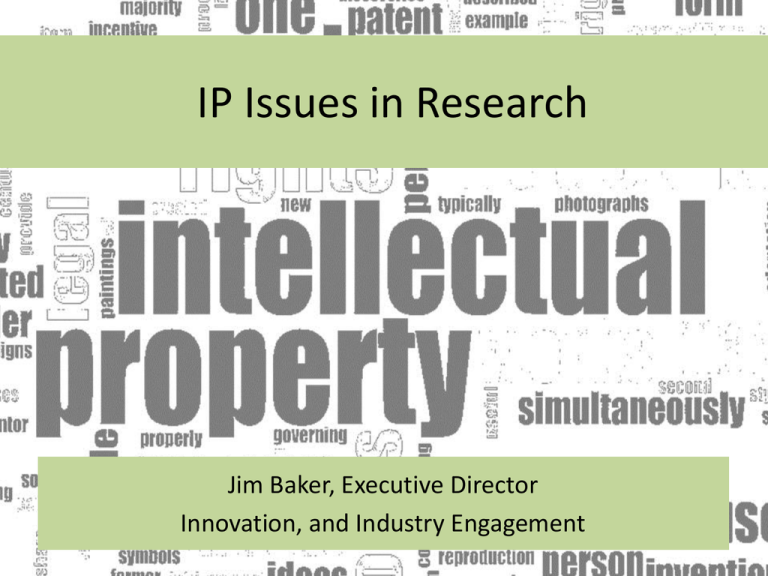
IP Issues in Research Jim Baker, Executive Director Innovation, and Industry Engagement Objectives • Inform researchers on issues related to intellectual property in research. – Relevant laws, policies, and rationale for University approach to IP rights. – Basics of patenting, commercialization, and patent licensing. – Relationship of IP rights to general progress and advancement of academic research programs. • Breadth versus depth – follow up for details. Outline • Background – Terminology – University Policies – Federal Rules • • • • Federal Contracting Issues Industrial Contracting Issues Patent Commercialization and Licensing Basics Using IP to grow your Research Program Terminology • Ownership – Sole control of an asset (Intellectual Property (IP) in this context). – Subject to any legal encumbrances. • License – The right to use an asset/IP. • Exclusive License – A license under which the licensor agrees to not provide licenses to any third party. • Non-Exclusive License – A license under which the licensor reserves the right to provide licenses to third parties. University Policies Relevant Federal Rules • 37 CFR 401 (Bayh-Dole Act) – Universities own inventions created from work sponsored by the federal government • IRS Revenue Procedure 2007-47 (Tax Free Bond Act) – Prohibits use of tax-exempt financed buildings for “private use” – Private use includes transferring IP ownership to sponsors at less than market value Federal Contracting Issues • Bayh-Dole provides the University with ownership of inventions • Simplifies contracting but comes with conditions – Legal and contractual obligations to disclose inventions to the funding agency. – Obligation to pursue commercialization • in the United States • with a preference for small businesses if possible. Industrial Contracting Issues • University owns project generated IP • University grants sponsors: – A royalty-free right non-exclusive license. – The first option to a royalty bearing exclusive license. • Tax-free bond act generally prohibits transfer of ownership and up-front designation of license terms. • Research rights/Freedom to operate Technology Commercialization Process Commercialization Stage Probability of Success Idea Invention Patent License Commercialization Steps Development Demonstration Enablement Invention Disclosure Effort/Time Get Started – Invention Disclosure • University forms • Know the details • Identify applications/partners Technology Assessment • Technical maturity – What needs to be done to reach the market – What are the related research needs/opportunities • Patentability • Is the invention ‘enabled’ – can it be reproduced • Will a patent impact our ability to attract research funding and commercial partners. • Market • Is there sufficient probability and magnitude value of revenue (research or royalty) to justify the investment. Leveraging IP for Research • Technology commercialization produces funding opportunities: – Corporate partner research sponsorship – Federal Small Business Innovation and Technology Transfer Research (SBIR/STTR) – Private Investment – Specialized technology gap funds – Business plan competitions Example of Research and Commercialization Alignment • Discovery from federal research that has potentially significant public benefit and commercial potential. – $20k proof of concept study • Michigan Universities Commercialization Initiative (MUCI). – $60k next stage proof of concept • Funded by MUCI • Support letter from private sector partner. – $230k validation study • $70k MUCI • $160k from private sector partner with an option to license technology – $230k development/further research • NIH STTR Phase I • $110k subcontract to Michigan Tech – Currently preparing $1.3M NIH STTR Phase II • $370k subcontract to Michigan Tech Example Outcomes to-date • ~ $800,000 in sponsored research – 3 years Ph.D. student funding – 2 years lab tech funding • • • • 4 publications in preparation 6 published conference proceedings $25,000 in royalties Equity in startup company (indeterminate value) Funding Opportunities • Early stage technologies – Funding available through traditional research funding programs • Mid-stage technologies – Technology gap funds – SBIR/STTR – need corporate partner • You can create that partner or we can seek one out – Startup company with private investment • Demonstrated Technology – Corporate sponsored research and development Michigan Tech Experience Base • Michigan Tech is a national leader in: – Proportion of research sponsored by industry – Number of license agreements per dollar of research – Number of invention disclosures per dollar of research • As a result we have staff experienced in: – – – – Appropriate contract term negotiation Managing conflicts of interest Startup business development Commercialization planning and implementation Contacts Jim Baker Executive Director, Innovation and Industry Engagement jrbaker@mtu.edu 487-2228 Robin Kolehmainen Patent/License Manager rakolehm@mtu.edu 487-2228 Web Resources Intellectual Property Internal Forms: http://www.mtu.edu/research/references/forms/#ted
